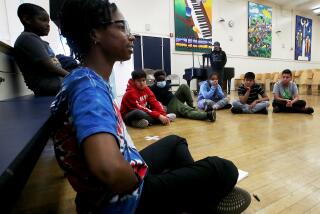180 Days of Learning
- Share via
For students in at least 70 Orange County public schools, “back-to-school” time is not necessarily at the end of the summer.
They’ve been hitting the books for several weeks already in Santa Ana, Orange, Anaheim and a few other areas where schools are running full-time in the dog days of August by choice or necessity. Those students and their parents should stand now and take a bow.
But for the county’s other 450 or so public schools, the new year starts in a frenetic 10-day period after Labor Day. Once again, students will get 180 days (give or take a few) of learning time.
The 27 school districts in charge of managing public education in Orange County have not been idle while most of their students have been on vacation.
Educators have been wrestling with policy and curriculum issues, of course. And many teachers have been back in school themselves to master new pedagogical techniques.
Some in Orange Unified School District are expected to use a new English immersion program for the first time with non-fluent students who had previously been taught in a bilingual format (though that policy move is so controversial it has been challenged in court).
Teachers in Garden Grove are working with new reading textbooks. In Placentia and Yorba Linda, math teachers are putting in place a new requirement for every student to pass algebra by the graduating class of 2002.
But for the most part, summer has been a season for hard hats on campus. Educators are touting construction projects that they say will pay dividends through this school year and beyond. The key issues driving the building are technology and smaller classes.
By “technology,” schools mean computers and the wiring to link them to the Internet. No educator these days wants to be caught without a technology program. Every new school is designed with computers in mind, and many older schools are getting retrofitted. Saddleback Valley Unified School District is a prominent example. By fall, district officials say, they will have Internet access in all 1,200 classrooms and libraries.
Skeptics say the money would be better spent on books, teachers or even air-conditioning. (Ever been in an uncooled classroom in Fullerton in late May?) But many education experts say computers are one of the most important investments a school can make.
“There’s very clear evidence that computers are very powerful tools in teaching writing and math skills,” said Louise Adler, chair of the education division at Cal State Fullerton. “It isn’t like the computers are isolated from the rest of the curriculum.”
The state’s heralded small-class initiative, now in its second year and with increased funding from Sacramento, also is forcing educators to take up hammer and nail.
Some background: California schools last summer began hiring an army of new teachers for kindergarten through third grade in an effort to cap class size at no more than 20 students apiece. Previously, the average was nearly 30 students a class. The aim is to give California’s youngest students a running start in reading and math skills.
In the first year of the program, most districts installed portable classrooms to make space for all the new teachers and their pupils. They are still doing that. But now, many districts have launched a more substantial overhaul. They are reopening schools that had long been closed (which also means new attendance boundaries). And they have redesigned the interiors of other schools--tearing down walls and putting up new ones to maximize the number of classrooms on each campus.
It is neither easy nor cheap to make over a school. But the small-class initiative is so popular that administrators are making few complaints. They only ask for some time to catch their breath. Most are busy enough just keeping up with booming enrollment. Last fall, the student population grew 4% countywide, to 443,000. Some areas grew by more than 7%. There is little evidence to suggest the rate of growth this fall will slacken much.
“We kind of hope we have a year without new things,” said Mac Bernd, superintendent of Newport-Mesa Unified School District, which is reopening two closed campuses to make room for smaller elementary classes. “We are trying to determine what normalcy is and see if we can possibly experience it.”
Here are highlights of new programs, policies and personnel district by districts across Orange County.
More to Read
Sign up for Essential California
The most important California stories and recommendations in your inbox every morning.
You may occasionally receive promotional content from the Los Angeles Times.













